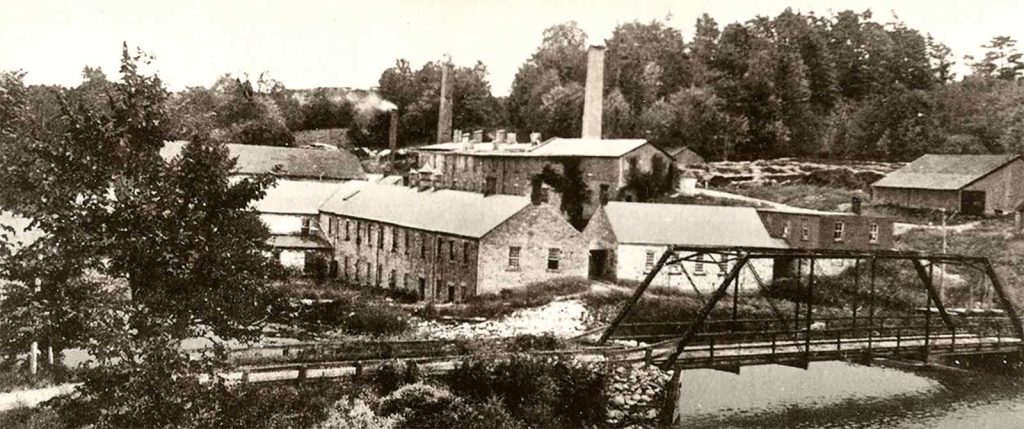In 1781 the British Government started purchasing land from the Mississauga Nation and in 1818, they bought what are now the townships of Esquesing and Nassagaweya. Charles Kennedy was hired to survey the northern part of the townships and received land as payment for his work.
Georgetown. Kennedys, Williams and the Stewart brothers

In 1781 the British Government started purchasing land from the Mississauga Nation and in 1818, they bought what are now the townships of Esquesing and Nassagaweya.
Charles Kennedy was hired to survey the northern part of the townships and received land as payment for his work.
The Kennedy’s were five brothers – Charles, John, Morris, Samuel and George. They all acquired land close to one another in the Silver Creek Valley. A few years later, their brother-in-law, Benajah Williams came and settled in the area that is now Glen Williams. Charles Kennedy built a sawmill in the area where Main Street meets Wildwood Road. George Kennedy built another mill off of the 10th line and that became the centre of a small settlement.
At the same time the Stewart Brothers had a prosperous mill a short distance to the west, in Esquesing Village, now called Stewarttown. It was on the main north-south route to the steamships at the Oakville harbour.
James McNab also had a prosperous mill in Norval.

In 1828, John Galt opened the road which connected the settlement around the three mills.
Town becomes known as Georgetown
Kennedy’s Mill was prosperous and he added a grist mill, foundry and a woollen mill, using the power provided by Silver Creek. But the business slowed down, (which is where the nick-name ‘Hungry Hollow’ comes from) and around 1834-1837 George sold the mills to the Barber brothers.
It was about 1837 when the area became to be known as Georgetown. When Georgetown was booming, in the 1850s, George Kennedy had his land split into town lots and named the streets after his children. ( You thought naming the car after your kid was generous). He died in 1870. George Kennedy played an important part in transforming what had been farm land into a prosperous industrial town.
The Barber brothers build a mill
They produced more wallpaper than any other plant in the province, and that was only by 1850s! The Barbers were also the first manufacturers in North America to operate their mills by hydro electric power. The paper mill and the ruins of the electric dynamo can still be seen along the Credit River and I wonder what made the builder give up on his plans to rebuild the mill?

Railroad brings new opportunities for the farmers
In May 1852 a rail route through Georgetown, Brampton and Weston to Toronto was announced and four years later, in 1856, after the Grand Trunk Railway was opened, Georgetown became the railroad centre. About 20 years later it was connected with the Hamilton and Northwestern Railway. In 1917 a rail connection to the Toronto Suburban Railway was inaugurated (also known as the Radial Line since it radiated out of the centre of Toronto). This was very important for Georgetown as it connected industry and farmers with the city. It also brought plenty of business to hotels such as the Railroad Exchange (still across from the railway station). The Clark and Bennett Houses were the hot spots of the time where traveling salesmen would close the deals with local farmers.
1900′ development. Town grows.
The town started to grow rapidly after the arrival of Rex Heslop who transformed the farms on the eastern edge of town into the Delrex subdivision. Heslop was a businessman and developer ( also built Rexdale, Etobicoke). He developed Georgetown’s oldest subdivision, Delrex, and to make sure his legacy would not be forgotten, he named the streets after himself: Rexway, Heslop, Delrex.
Rex ran into political problems and got tired of cat fighting so he sold his investments. By 1960 Georgetown had reached a population of 10 000 and a year later the community had its own hospital.

Georgetown becomes a part of Halton Hills
Georgetown grew as new neighbourhoods were added. The oldest section is around Main Street and Church Street. The arrival of the railway produced a new section – around King Street and Queen Street. The Delrex subdivision was the third part of the town that was added. Shortly after Delrex and Moore Park were built.
In January 1, 1974, Georgetown, Acton, Milton, Oakville, Burlington and most of the Esquesing Township became part of the Regional Municipality of Halton. Which is now known as the Town of Halton Hills. New neighbourhoods grew: Georgetown South in 1989, Arbour Glen, Stewart Mills and Four Corners. And the town keeps flourishing.
Historical photos were generously provided by the Esquessing Historical Society.
Visit Esquessing Historical Society website
